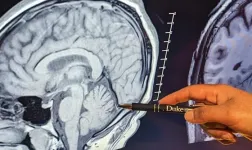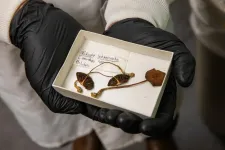(Press-News.org) A new paper in Molecular Biology and Evolution, published by Oxford University Press, finds that HIV populations in people with higher viral loads also have higher rates of viral recombination. In effect, the more HIV in the blood, the easier it is for the virus to diversify.
One of the reasons HIV has historically been so difficult to combat is the virus’s exceptionally high rate of recombination. Recombination enables the exchange of genetic information across strains of the virus and drives HIV’s evolution within people. This genetic exchange helps the virus evade the immune system and become resistant to many drugs designed to treat HIV.
More generally, recombination is an important evolutionary driver, permitting organisms to purge destructive mutations and combine beneficial ones. Despite its importance, scientists do not yet understand how HIV’s recombination rate varies throughout an infection or between different people. Understanding the factors that impact recombination rate in a well-studied system such as HIV can help uncover some of the effects that recombination has on evolution more broadly.
One important yet understudied step in HIV recombination is coinfection, in which two different virus particles infect the same cell. Despite longstanding interest in HIV recombination, we do not yet understand if variation in the rate of coinfection could lead to variation in recombination rate. While studies of HIV in cell cultures and mice have demonstrated that increased coinfection is associated with an increase in recombinant viruses, it is unknown if this effect is found in people living with HIV.
The researchers involved with this study hypothesized that people with higher viral loads (more HIV in the blood) would have more cells that were coinfected, which would lead to higher rates of recombination for the virus. To investigate this hypothesis, they developed a new approach called Recombination Analysis via Time Series Linkage Decay (RATS-LD) to quantify recombination using genetic associations between mutations over time.
This investigation found that while HIV populations with viral loads in the lowest third of the data set have recombination rates in line with previous estimates, populations with viral loads in the upper third have a median recombination rate that is nearly six-fold higher. Furthermore, the researchers observe patterns of viral load and effective recombination rate increasing simultaneously within single individuals.
These results suggest that rates of HIV recombination can be even more extreme than researchers recognized previously. Beyond HIV, many organisms such as bacteria and plants do not need to recombine to reproduce but can benefit from it. To exchange genetic material, these organisms also rely on two different genomes meeting each other at the same place and time. Because of this, the researchers’ findings also suggest that population density could influence the effective rate of recombination across multiple settings.
“An explosion of sequencing data over the past few decades has given geneticists a deeper understanding that recombination rates can be context-dependent and are influenced by many different molecular factors,” said Elena V. Romero, one of the authors of the paper. “Here, we show that population density may serve as one of those previously underappreciated factors for viruses.”
The paper, “Elevated HIV viral load is associated with higher recombination rate in vivo,” is available (on January 10th, at midnight) at https://academic.oup.com/mbe/article-lookup/doi/10.1093/molbev/msad260.
Direct correspondence to:
Elena V. Romero
Department of Genome Sciences
University of Washington
Seattle, WA
evromero@uw.edu
To request a copy of the study, please contact:
Daniel Luzer
daniel.luzer@oup.com
END
Higher viral load during HIV infection can shape viral evolution
2024-01-10
ELSE PRESS RELEASES FROM THIS DATE:
More than 900 chemicals, many found in consumer products and the environment, display breast-cancer causing traits
2024-01-10
With tens of thousands of synthetic chemicals on the market, and new ones in development all the time, knowing which ones might be harmful is a challenge both for the federal agencies that regulate them and the companies that use them in products. Now scientists have found a quick way to predict if a chemical is likely to cause breast cancer based on whether the chemical harbors specific traits.
“This new study provides a roadmap for regulators and manufacturers to quickly flag chemicals ...
Agility in cultural heritage management—Advancing competence within uncertainty as a sustainable and resilient adaptation to processes of dynamic change
2024-01-10
The intense changes in our modern society and the associated challenges are constantly increasing, not least due to the meta-crisis of climate change. Yet our approach to cultural heritage is still strongly influenced by the narrative of preservation. The article aims to find solutions within the interplay of preservation and change. Based on the psychological impact on society resulting from the current challenges, it is argued that cultural heritage experts need competencies in dealing with uncertainty and tolerance of ambiguity in order to provide security of action. The article applies insights from multiple disciplines to urban environment studies and advocates for a systemic understanding ...
Prestigious American Historical Review showcases UT class where video games meet history
2024-01-10
Tore Olsson put his students in touch with American history through his popular and award-winning class “Red Dead America: Exploring America’s Violent Past Through the Hit Video Games.” Now this engagement has reached beyond the classroom—the historical profession’s most prestigious journal, the American Historical Review, just published a major feature on the class as an example of creative and innovative history teaching.
Olsson is an associate professor and director of graduate studies in UT’s Department of History. His focus as a historian is the United States since the Civil War, with a particular interest in the US South, ...
Observing single protein with infrared nanospectroscopy
2024-01-10
Infrared vibrational spectrum of a single protein is observed using advanced measurement techniques based on near-field optical microscopy. This method utilizes light confined at the nanometer scale, allowing for the detailed analysis of extremely small samples, which was previously challenging with conventional infrared spectroscopy. The achievement represents a major advancement towards technological innovations such as ultra-sensitive and super-resolution infrared imaging, as well as single-molecule vibrational spectroscopy.
Infrared ...
Volume of grey brain matter significantly lower in people with Early Onset Psychosis
2024-01-10
New research from the Institute of Psychiatry, Psychology & Neuroscience has found an association between a reduction in grey matter in the brain and Early Onset Psychosis (EOP).
The study, published in Molecular Psychiatry, is the largest ever brain imaging study in EOP and has provided unprecedented levels of detail about the illness. It shows that, in contrast to other mental health disorders, people with EOP have a reduced volume of grey matter across nearly all regions of their brain. Researchers hope that this detailed mapping ...
Duke-NUS scientists discover potential nasal COVID-19 vaccine candidate that offers better and longer protection
2024-01-10
Novel findings from a preclinical head-to-head comparison show that administering a COVID-19 vaccine as a nasal spray rather than a subcutaneous injection enhances the body’s long-term immune memory, thereby increasing the vaccine’s overall effectiveness.
This research could pave the way for a COVID-19 vaccination strategy that depends on fewer boosters to achieve the same level of protection against SARS-CoV-2 viruses.
SINGAPORE, 10 January 2024 – A team of scientists, led by Duke-NUS Medical School, has discovered a potential intranasal vaccine candidate that provides improved, ...
Traumatic stress associated with smaller brain region
2024-01-10
DURHAM, N.C. – Adults with posttraumatic stress disorder (PTSD) have smaller cerebellums, according to new research from a Duke-led brain imaging study.
The cerebellum, a part of the brain well known for helping to coordinate movement and balance, can influence emotion and memory, which are impacted by PTSD. What isn’t known yet is whether a smaller cerebellum predisposes a person to PTSD or PTSD shrinks the brain region.
“The differences were largely within the posterior lobe, where a lot of the more cognitive functions attributed to the cerebellum seem to localize, as well as the vermis, which is linked to a lot of emotional processing ...
Largest diversity study of ‘magic mushrooms’ investigates the evolution of psychoactive psilocybin production
2024-01-10
Psilocybe fungi, known colloquially as “magic mushrooms,” have held deep significance in Indigenous cultures of Mesoamerica for centuries. They captured the wider world’s attention as a psychedelic staple in the 60s and 70s. Now, these infamous organisms are at the forefront of a mental health revolution. Psilocybin and psilocin, the psychoactive compounds found in nearly all species of Psilocybe, have shown promise as a treatment for conditions including PTSD, depression, and for easing end-of-life care.
To ...
Sex-specific panel of 10 proteins can pick up 18 different early stage cancers
2024-01-10
A sex-specific panel of 10 proteins can pick up 18 different early stage cancers, representing all the major organs of the human body, finds a proof of concept study published in the open access journal BMJ Oncology.
The findings could kick-start a new generation of screening tests for early detection of the disease, say the researchers, particularly as there are many sex specific differences in cancer—including age at occurrence, cancer types, and genetic alterations—points out a linked editorial.
Cancer accounts for 1 in every 6 deaths around the globe, with nearly 60% of these deaths ...
Predominantly plant-based or vegetarian diet linked to 39% lower odds of COVID-19
2024-01-10
A predominantly plant-based or vegetarian diet is linked to 39% lower odds of COVID-19 infection, finds research published in the open access journal BMJ Nutrition Prevention & Health.
The findings prompt the researchers to suggest that a diet high in vegetables, legumes, and nuts, and low in dairy products and meat may help to ward off the infection.
Several studies have suggested that diet may have an important role in the evolution of COVID-19 infection, as well as in the factors that heighten the risk of its associated ...




